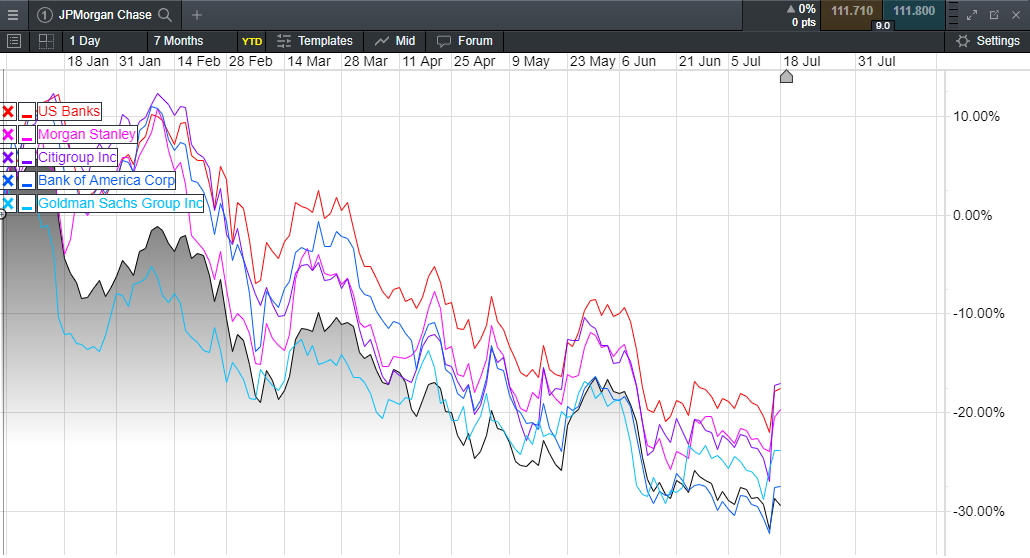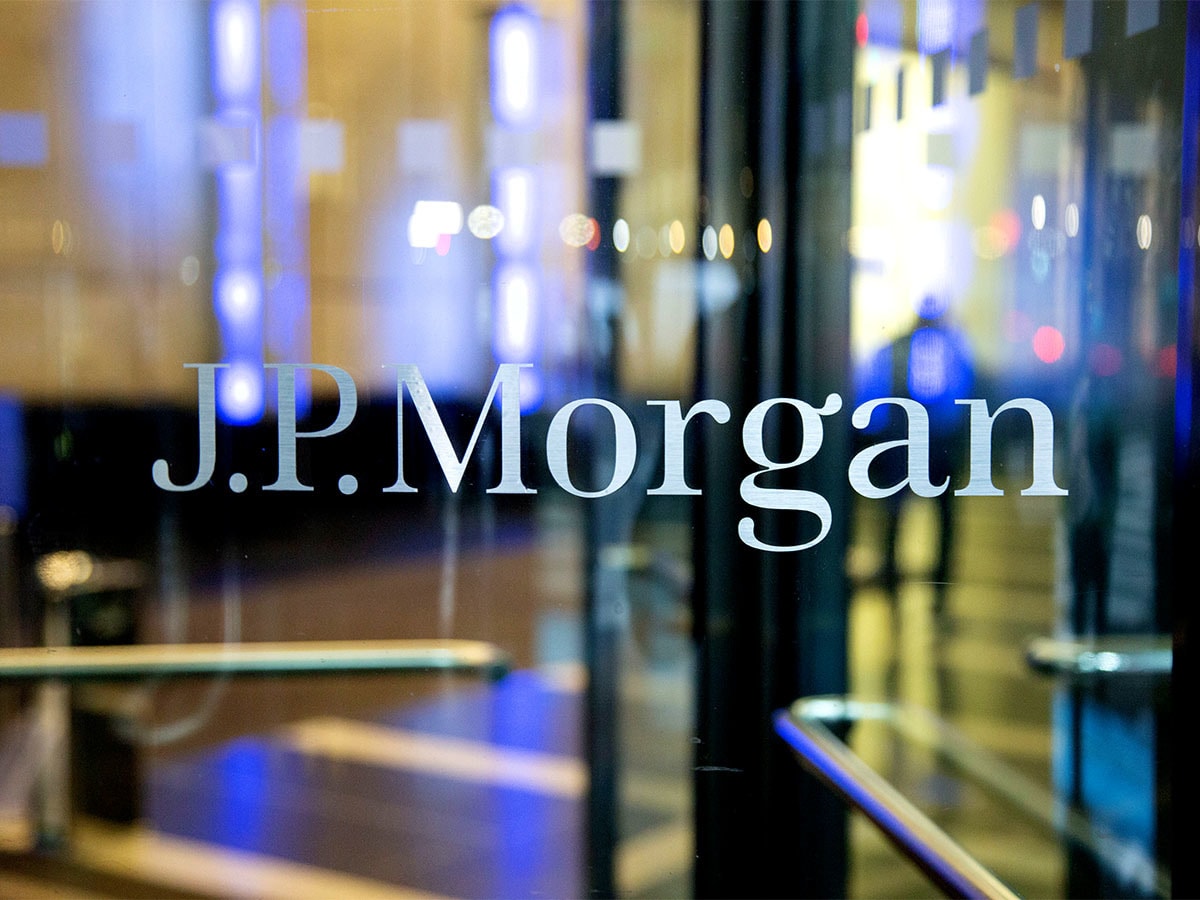After a decent 2021, during which our US banks share basket posted gains just shy of 40% as shares in the likes of JPMorgan Chase and Goldman Sachs hit record highs, the first six months of 2022 have brought a significant correction. This has wiped out a good proportion of the gains we saw after the pandemic-era lows of 2020.
Morgan Stanley initially bucked the trend, its shares briefly reaching a record high in February. However, since those peaks, losses in the US banking sector have accelerated, driven in part by the fallout from Russia's invasion of Ukraine.
Gathering stormclouds
It would be easy to argue that events in eastern Europe were the sole catalyst for the moves lower that we’ve seen so far this year, but in truth the signs were there even as we approached the end of 2021.
Shareholder angst was already apparent in last November's sharp sell-off of JPMorgan Chase shares on concerns over its consumer business and, in particular, loan growth. The latter had been cited as a concern as far back as Q2 last year.
One particular issue that affected all US banks last year was the release of reserves that they had set aside during the pandemic to cover possible loan defaults amid concerns over rising unemployment. The level of defaults that was feared never materialised, thanks primarily to unprecedented fiscal support from the US government which protected jobs and the wider US economy. In many cases, the support may have been too generous. Last year, banks released their bad debt provisions, boosting payouts in the short term.
With these one-off balance sheet boosts firmly in the rear-view mirror, and with an economic slowdown looming as the Federal Reserve signalled a change in monetary policy, many investors cashed out of the banking sector.
The weakness that we started to see in the sector at the end of last year accelerated after Q4 numbers were announced in January. The banks' results revealed increased costs and a downturn in retail lending, indicating that the economy was weakening.
US banks' performance – 2022 to date

Source: CMC Markets
Banks faced headwinds in the first half of the year
In January JPMorgan Chase reported a decrease in home lending and personal credit for Q4, with higher interest rates a factor in sending home lending revenue down 26% to $1.1bn. Credit card and auto loan revenues fell 9% to $5bn.
It was a trend that was replicated at Citigroup, whose retail business saw a big decline in revenue. Services revenue fell to $1.3bn, while mortgage lending also fell as costs rose.
April gave us the Q1 numbers. Although revenues from US banks' trading and fixed income divisions were holding up reasonably well, margins were coming under pressure. There were a number of reasons for this. Economic conditions became less supportive, as the Federal Reserve tightened monetary policy while Russia upended the global economy by invading Ukraine.
These headwinds prompted a safety-first approach among US banks as they set aside reserves to cover potential credit losses linked to rising inflation. This increase in provisions coincided with a sharp rise in consumer credit which, after a weak January, exploded in the subsequent three months, rising to a record high of $47.34bn in March. We also saw increases of $37.7bn in February and $36.76bn in April, adding up to a total of almost $122bn in three months. That's roughly equivalent to the amount we saw in the last six months of 2021.
Goldman Sachs set aside $561m in Q1 to cover credit losses related to growth in its credit card portfolio. It followed that up with a further $667m in Q2.
JPMorgan Chase also upped provisions for credit losses, adding $1.5bn in Q1 and $1.1bn in Q2, as higher prices ate into consumers' spending power. The credit loss provisions appear to be a response to a sizeable increase in loans, although mortgage lending has remained subdued, with the bank announcing at the end of June that it plans to lay off or re-allocate over 1,000 employees in its mortgage unit.
Bank of America has come across in recent months as being more bullish about the US consumer and the economy, even if its share price performance doesn’t reflect that optimism. CEO Brian Moynihan was upbeat on the outlook in April, saying that US consumers were still sitting on sizeable amounts of cash. This seems doubtful if credit card lending growth is any guide. But the bank remained bullish at the release of their Q2 numbers earlier this month, although they did set aside $523m for credit losses.
Together, US banks have also had to pare back their Russia exposure, incurring varying costs. Citigroup said that it expects to incur losses of $2bn in a worst-case scenario, setting aside $1.3bn in the process.
Outlook concerns
Looking ahead to the rest of the year, JPMorgan warned that the deteriorating economic outlook would likely impact the banking sector's performance going forward. The bank cited high inflation, geopolitical uncertainty stemming from Russia's actions in Ukraine, and the Federal Reserve hiking rates into a slowdown.
Consumer spending in the US is holding up for now, but high inflation could force many people to economise in the coming months. Gasoline prices have started to fall in the last few weeks, easing the pressure on consumer wallets, though other price pressures – such as food price inflation – could hit shoppers' pockets as winter approaches.
Much will depend on how the US economy performs over the rest of the year. While we’ve seen a modest rebound in US bank share prices in the last few days, we’re still very much in the downtrend that followed the February peaks.
Disclaimer: CMC Markets is an execution-only service provider. The material (whether or not it states any opinions) is for general information purposes only, and does not take into account your personal circumstances or objectives. Nothing in this material is (or should be considered to be) financial, investment or other advice on which reliance should be placed. No opinion given in the material constitutes a recommendation by CMC Markets or the author that any particular investment, security, transaction or investment strategy is suitable for any specific person. The material has not been prepared in accordance with legal requirements designed to promote the independence of investment research. Although we are not specifically prevented from dealing before providing this material, we do not seek to take advantage of the material prior to its dissemination.






